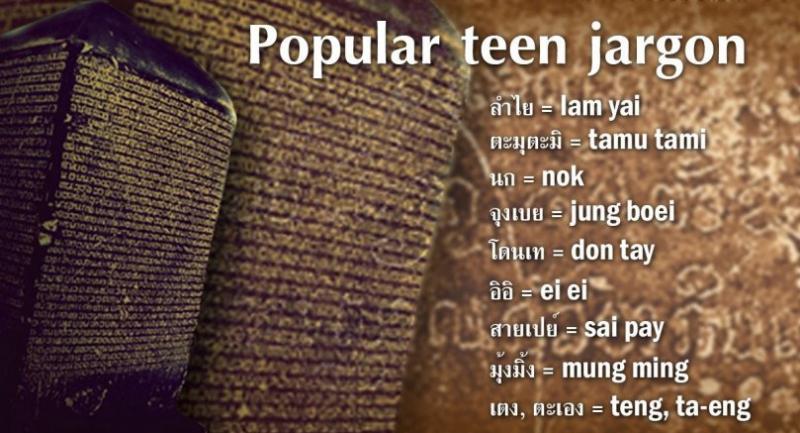Evolving Thai language is so ‘tamu tami’

THE SLANG TERMS popular among young people this year are a mixed bag, with the most references accruing to lam yai, which means to feel annoyed; tamu tami, “cute” or “adorable”; and nok, or a person whose flirtations have been rejected.
Those were the results of a recent survey conducted by the Culture Ministry and Suan Dusit Poll, which also found that 65.4 per cent of respondents knew about Thai Language Day, which falls on July 29 every year.
The poll surveyed the opinions of 3,306 children, young people and other members of the public nationwide.
Culture Minister Veera Rojpojanarat said 57.34 per cent of respondents knew the day had been established to mark His Majesty the late King Bhumibol Adulyadej’s participation in a discussion about the Thai language at Chulalongkorn University’s Faculty of Arts on July 29, 1962.
Respondents cited the most popular slang, in descending order, with 39.44 per cent referring to lam yai, 36.86 per cent to tamu tami and 36.23 per cent to nok.
Other top contenders in the lexicon included jung boei, which means “very much”, as in jung loei, but with a child’s lisp (34.67 per cent); tay or don tay, meaning to abandon or to be abandoned (34 per cent); ei ei, a tongue-in-cheek laughing expression (33.61 per cent); pay or sai pay, meaning a person who likes to treat others (30.12 per cent); teng, ta-eng or tal-eng, all of which mean “you” with a connotation of closeness like addressing a boyfriend or girlfriend (27.28 per cent); and mung ming, which is another way to say “cute” (26.06 per cent).

Most respondents, 83.45 per cent, said the person with the most outstanding Thai-language skills was the early Rattanakosin-era poet Phra Sunthonwohan, better known as Sunthorn Phu (1786-1855).
King Rama II, who is more formally known as Phrabatsomdet Phra Phutthaloetla Naphalai, was also cited in 41.16 per cent of answers, followed by the famous Thai tutor Kitmanoch “Kru Lilly” Rojanasupya at 39.38 per cent, SEA Write Award-winning poet and national artist Naowarat Pongpaiboon at 38.43 per cent, and the Thai tutor Jakkriz “Kru Tom Khamthai” Yompayorm at 37.6 per cent. The survey accepted more than one answer.
Accuracy and appropriate usage representing the country’s culture were also concerns, with most respondents, 39.02 per cent, focusing on the spoken language followed by writing and Thai reading at 37.17 and 23.81 per cent respectively.
The poll concluded that 53.86 per cent of respondents knew about the country’s master plan to promote reading and learning from 2017 to 2021, with 55.16 per cent believing the plan would help people to achieve the goal of reading 90 minutes a day. However, 29.79 per cent disagreed, saying that many people did not like reading, had short attention spans, and were more keen to play games and use their smartphones.
Regarding time spent reading via various media, 56.59 per cent said they read online media three hours a day. With more than one choice available, 37.42 per cent said they read books or documents one-and-a-half hours per day, while 36.90 per cent said they read newspapers and 18.63 per cent general journals for one hour a day.
Respondents also recommended that the Culture Ministry and related agencies host Thai language and reading activities at schools, organise annual Thai language contests with prizes, launch online campaigns promoting the proper use of the language, and organise reading, writing and speaking training sessions.
They also responded that more time should be spent in classrooms reading, or it should be added as a separate subject in school curricula.
